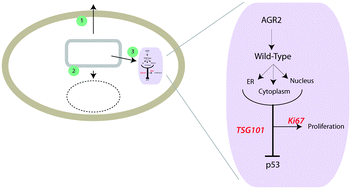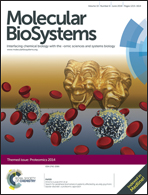Engineering a synthetic cell panel to identify signalling components reprogrammed by the cell growth regulator anterior gradient-2†
Abstract
AGR2 forms an ER-resident signalling axis in cell development, limb regeneration, and in human diseases like asthma and cancer, yet molecular mechanisms underlying its effects remain largely undefined. A single integrated Flippase recombination target (FRT) site was engineered within the AGR2-non expressing A375 cell line to allow integration of a constitutively expressed AGR2 alleles. This allows an analysis of how AGR2 protein expression reprogrammes intracellular signalling. The engineered expression of AGR2 had marginal impact on global transcription signalling, compared to its paralogue AGR3. However, expression of AGR2 had a significant impact on remodelling the cellular proteome using a triple-labelled SILAC protocol. 29 045 peptides were detected for the identification and relative quantitation of 3003 proteins across the experimental conditions. Ingenuity Pathway annotation highlighted the dominant pathway suppressed by wt-AGR2 was the p53-signalling axis. DNA damage induced p53 stabilization and p21 induction by cisplatin treatment confirmed that wt-AGR2 expression suppressed the p53 pathway. The furthest outlying SILAC protein expression change induced by AGR2 was the anti-viral and cell cycle regulator tumour susceptibility gene 101 (TSG101), confirmed by immunoblotting. Transfection of TSG101 into MCF7 (AGR2+, oestrogen dependent), A549 (AGR2+, oestrogen independent) or A375 (AGR2−) cells confirmed that TSG101 attenuates p53 signalling. These systems wide screens suggest that the most dominant landscape reprogrammed by low levels of AGR2 protein is the cellular proteome, rather than the transcriptome, and provide focus for evaluating its role in proteostasis.


 Please wait while we load your content...
Please wait while we load your content...